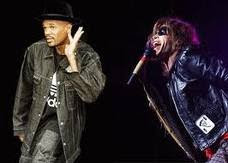
The Boston-based group Aerosmith had a hit with the song Walk This Way in the winter of 1976-1977 getting to #10 on the charts.
Then the rap trio from Queens, NYC, Run-D.M.C., covered Walk This Way, significantly including Aerosmith’s Steve Tyler on vocals and Joe Perry on guitar. That version got to #4 in 1986 on the pop charts and #8 on the black charts.
What I loved about the latter version is probably anathema to librarian types. I HATE categories in music. I find it at least as divisive as I find it informative. It seems to create the mindset of “I don’t like THAT kind of music,” when I believe there is a basic commonality of music that defies boundaries.
After the latter version hit, Run-D.M.C. continued to have success on the black or R&B charts and even had some minor hits on the pop charts.
After having only two Top 20 hits, the other being the longer version of Dream On (#6 in 1976), and not even a Top 100 on the US pop charts since 1979’s “Remember (Walking in the Sand)” which only got to #67, Aerosmith exploded commercially in the late 1980s, including “Dude (Looks Like a Lady)” (#14 in 1987); “Angel” (#3 in 1988), “Rag Doll” (#17 in 1988); “Love in an Elevator” (#5 in 1989), “Janie’s Got a Gun” (#4 in 1989); then more hits into the 1990s.
***
Incidentally, the name of the charts of music generally associated with African-Americans has changed several times, from rhythm & blues (or R&B) to soul to black, back to R&B to R&B/hip-hop. At least they stopped using the term “race records” back in the 1940s.
